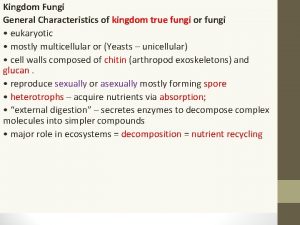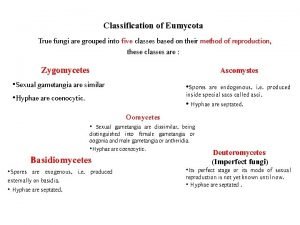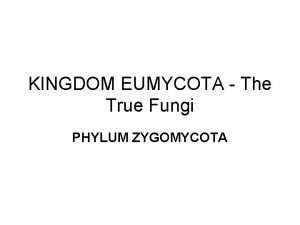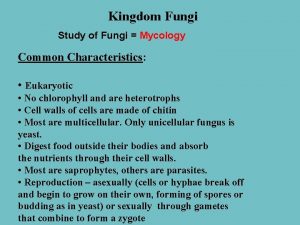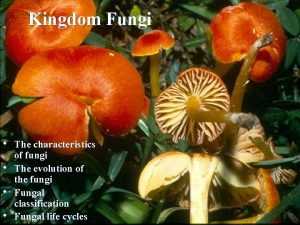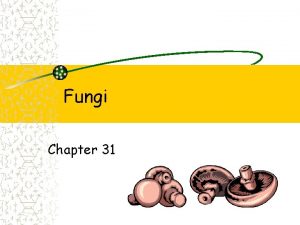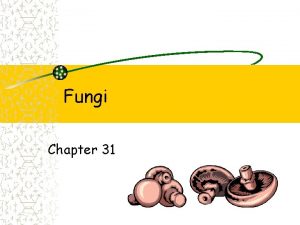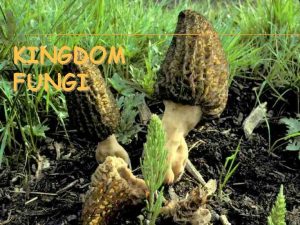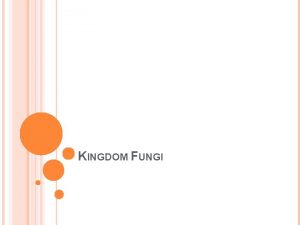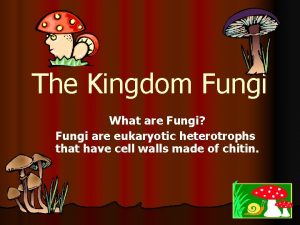Kingdom Fungi General Characteristics of kingdom true fungi












- Slides: 12

Kingdom Fungi General Characteristics of kingdom true fungi or fungi • eukaryotic • mostly multicellular or (Yeasts – unicellular) • cell walls composed of chitin (arthropod exoskeletons) and glucan. • reproduce sexually or asexually mostly forming spore • heterotrophs – acquire nutrients via absorption; • “external digestion” – secretes enzymes to decompose complex molecules into simpler compounds • major role in ecosystems = decomposition = nutrient recycling


• Phylum : - chytridiomycota (single posterior flagellum) • Chytridiomycota, a phylum of fungi (kingdom Fungi) distinguished by having zoospores (motile spores) with a single, posterior, whiplash flagellum. Species are microscopic in size, and most are found in freshwater or wet soils. Most are parasites of algae and animals or live on organic compounds (as saprobes). A few species in the order Chytridiales cause plant disease, and one species, has been shown to cause disease in frogs and amphibians.

• Many studies were shown most fossils of fungi belonged to chridiomycota and this confirms that this is a fungus that first appeared Which is believed to have evolved from flagellated protista. • the individuals of this kingdom also is called lower fungi or algal fungi that is forming aseptated hyphae (coenocytic) • . The Chytridiomycota, often called chytrids, are unique among all fungi in having motile spores in their life cycles , The phylum has a single class, Chytridiomycetes,

• • Cell walls are made of chitin and glucan , cellulose is not known to occur. Chytridiomycota feed on both living and decaying organisms. They are heterotrophic and absorptive nutrition They are mostly aquatic, and not terrestrial. Sexual reproduction is variable and may be isogamous, anisogamous or oogamous. Asexual reproduction by zoospores have a single, posterior whiplash flagellum. Some individuals have alternation of generation in their life cycle Somatic phase consists from unicellular with rhizoids or multicellular (mycelium with aseptated hyphae ).

• Rhizoids : it is a part of somatic phase or thallus , root like structure having protoplasm without nuclei bearing vegetative structures (zoosporangia ) some rhizoids bearing one zoosporangium per thallus – monocentric. Others produce multiple zoosporangia – polycentric • The benefit of rhizoids to confirm thallus on the surface of feed and increase surface area for absorption of nutrients ).


• Reproduction of chytridiomycota • Asexually, Chytridiomycota reproduce through the use of zoospores. In asexual reproduction, zoospores release from zoosporangium within a pore at the top of zoosporangium called operculum then will swim until located a fresh substrate each will eventually lose its flagellum , The nucleus undergoes several MITOTIC DIVISIONS - resulting in a multinucleate Finally, cleavage of the protoplasm occurs, which produces individual zoospores that are released through a pore.


• Sexual reproduction is haploid dominant. It also depends on the isomorphic alternation of generations. The haploid thallus, called the gametothallus, produces female and male gametes. These occur in pairs and are terminal and subterminal. Male gametes are orangecolored, while female gametes are colorless. In addition, female gametes are much larger than male gametes. • The diploid thallus is called the sporothallus. The sporothallus produces two types of zoosporgia: zoosporgangium (meitosporangium) and resistant sporangium (meiosporangium). Zoosporangia produce diploid zoospores, which can function as a means of asexual reproduction. while meiosporangium produce haploid zoospore after suffering meiosis division ,


